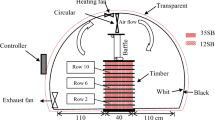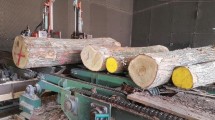Abstract
Eucalyptus grandis wood is susceptible to serious drying defects and all possible measures before and during kiln drying of poles need to be taken to minimize the defects. In order to identify factors that may affect drying quality of poles, the objective of this study was to assess relationships between surface check total length and depth, MC gradient, honeycomb percentage of pole cross section area, extent of collapse, sapwood depth, heartwood percentage of pole cross-sectional area, green MC and pole diameter. The defects were measured on 3 loads of 10 kiln-dried E. grandis poles, using a different drying schedule for each load. After measuring surface check length using a measuring tape and check depth using feeler gauges and a ruler, poles were cross cut at the theoretical ground line (TGL) 1.5 m from the butt end, to measure the MC gradient between the shell and core of poles. Digital image analysis of cross sections of discs cut at TGL was used to measure sapwood depth, and the areas of honeycomb, heartwood and disc cross section. Collapse was assessed using qualitative methods. Results showed that surface check total length was positively correlated with sapwood depth, and the average depth of surface checks was greater than the average sapwood depth. MC gradient between the shell and core was positively correlated with green MC while the transformed honeycomb percentage and collapse class were both positively correlated with heartwood percentage. It was concluded that pole drying defects are related to sapwood depth, green MC and heartwood percentage, and if pre-sorting of poles by these characteristics is done and appropriate kiln schedules are used, drying defects can be minimised.
Zusammenfassung
Eucalyptus grandis Holz ist sehr anfällig für Trocknungsfehler, weswegen vor und während der technischen Trocknung alles getan werden muss, um die Fehler so gering wie möglich zu halten. Um mögliche, die Trocknungsqualität von Masten beeinflussende Faktoren zu erkennen, hatte diese Studie zum Ziel, die Zusammenhänge zwischen der Länge und der Tiefe von Oberflächenrissen, dem Holzfeuchtegradienten, dem Anteil an Innenrissen im Mastquerschnitt, dem Ausmaß an Kollaps, der Splintholzbreite, dem Kernholzanteil am Mastquerschnitt, der Ausgangsholzfeuchte sowie des Mastdurchmessers zu beurteilen. Die Fehler wurden an drei Chargen aus jeweils zehn technisch getrockneten E. grandis Masten mit jeweils unterschiedlichen Trocknungsprogrammen bestimmt. Nach Messung der Länge der Oberflächenrisse mit einem Maßband und der Risstiefe mit einer Dickenlehre und einem Lineal, wurden die Masten am theoretischen Boden-Luft-Bereich (TGL) 1,5 m vom unteren Stammende aufgetrennt, um den Holzfeuchtegradienten im Masten zu bestimmen. Mittels digitaler Bildanalyse der im Boden-Luft-Bereich entnommenen Mastscheiben wurden die Splintholzbreite und die Fläche der Innenrisse, der Kernholzanteil und der Mastquerschnitt gemessen. Der Kollaps wurde mittels qualitativer Methoden bestimmt. Die Ergebnisse zeigten, dass die Gesamtlänge der Oberflächenrisse positiv mit der Splintholzbreite korreliert war, wobei die durchschnittliche Risstiefe größer als die durchschnittliche Splintholzbreite war. Der Holzfeuchtegradient im Mastquerschnitt war positiv mit der Ausgangsholzfeuchte korreliert, während der relative Anteil an Innenrissen sowie die Kollapsklasse positiv mit dem Kernholzanteil korreliert waren. Daraus wurde geschlossen, dass die Trocknungsfehler der Masten von der Splintholzbreite, der Ausgangsholzfeuchte und dem Kernholzanteil abhängen. Mit einer Vorsortierung der Masten nach diesen Eigenschaften und unter Verwendung geeigneter Trocknungsprogramme lassen sich Trocknungsfehler minimieren.










Similar content being viewed by others
References
Bariska M (1992) Collapse phenomena in eucalypts. Wood Sci Technol 26:165–179
Bowyer JL, Shmulsky R, Haygreen JG (2003) Forest products and wood science. An introduction. Fourth Edition. Iowa State Press, Iowa
Brown WH (1989) The conversion and seasoning of wood. Linden Publishing, Fresno, California
Chafe SC (1985) The distribution and interrelationship of collapse, volumetric shrinkage, moisture content and density in trees of Eucalyptus regnans F. Muell. Wood Sci Technol 19:329–345
Chafe SC, Barnacle JE, Hunter AJ, Ilic J, Northway RL Rozsa AN (1992) Collapse: An introduction. CSIRO Division of Forest Products, National Library of Australia
Chudnoff M (1955) The effect of zinc chloride on some shrinkage properties of Eucalyptus rostrata wood. Forest Prod J 5(2):139–141
Garratt GA (1931) The mechanical properties of wood. John Wiley and Sons Inc., London
Han M (1985) Drying and preserving poles in Latin America. Proceedings vol. 1 of the conference on wood protection and fundamental studies. Forest Products Research International Achievements and the future
Harris RA, Araman PA (1995) The correlation between green density and the occurrence of honeycomb in kiln-dried red oak lumber. Forest Prod J 45(5):53–54
Harris RA, Taras MA, Syme JH (1988) The correlation between green density and the occurrence of honeycomb in kiln-dried red oak rounds. Forest Prod J 38(7):64–66
Koehler A, Thelen R (1926) The kiln drying of lumber. First Edition. McGraw-Hill Book Company, Inc., New York
Morén TJ (1989) Check formation during low temperature drying on Scots pine: Theoretical considerations and some experimental results. Proceedings of the IUFRO International wood drying symposium, 23–28 July 1989. International Union of Forestry Research Organisations, Seattle, Washington, USA
Panshin AJ, De Zeeuw C, Brown HP (1964) Textbook of wood technology. Second Edition. McGraw-Hill Book Company, New York
Pratt GH (1974) Timber drying manual. McCorquodale Printers Ltd, London
Record S J (1914) Mechanical properties of wood. First Edition. John Wiley & Sons, Inc., New York
Stöhr HP (1977) The seasoning of South African grown Eucalyptus grandis and E. saligna sawn timber. South African Forestry Journal 102(9):61–66
Stöhr HP (1982) A study of kiln drying characteristics of E. grandis poles. CSIR contract report C/HOUT 235. National Timber Research Institute. Pretoria
Tiemann HD (1941) Collapse in wood as shown by the microscope. Journal of Forestry 39(3):271–283
Tsoumis G (1991) Science and technology of wood: structure, properties, utilization. Van Nostrand Reinhold, New York
Wangaard FF (1950) The mechanical properties of wood. John Wiley and Sons, Inc., New York
Wessels CB, Mugabi P, Rypstra T, Steinmann D, Vermaas HF (2004) Durability improvement of wooden utility poles. South African Wood Preservers Association (SAWPA) Interim Report 1. Stellenbosch University
Wilkins AP, Wilkes J (1987) Observations on the mechanism of collapse in wood. Journal of the Institute of Wood Science 11(2):89–92
Yang JL (1998) An attempt to reduce collapse through introducing cell-wall deformations. Wood Fibre Sci 30(1):81–90
Acknowledgements
The study was funded by Bedson PTY LTD and the Norwegian Agency for Development (NORAD) through Makerere University. We thank the South African Wood Preservers Association (SAWPA) and Stellenbosch University for providing research materials. We also thank Mr. A. Kunneke and Mr. W. Hendrikse for their technical contribution during data collection.
Author information
Authors and Affiliations
Corresponding author
Rights and permissions
About this article
Cite this article
Mugabi, P., Rypstra, T., Vermaas, H.F. et al. Relationships between drying defect parameters and some growth characteristics in kiln-dried South African grown Eucalyptus grandis poles. Eur. J. Wood Prod. 68, 329–340 (2010). https://doi.org/10.1007/s00107-009-0375-4
Received:
Published:
Issue Date:
DOI: https://doi.org/10.1007/s00107-009-0375-4




